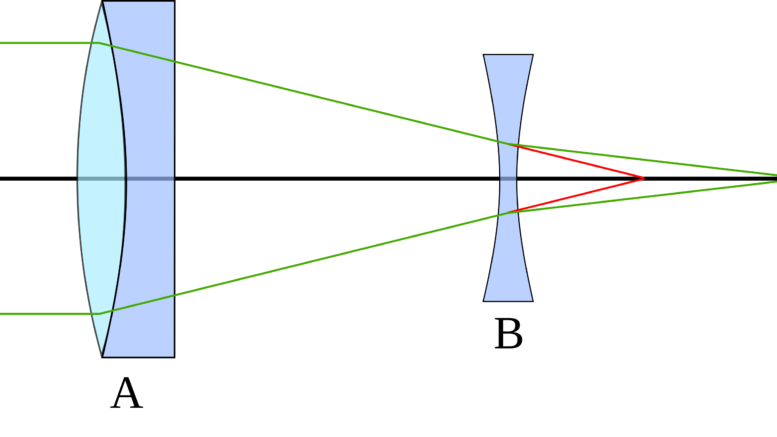Named after Peter Barlow, the Barlow lens is a diverging lens which, which is used in series with other optics in an optical system to increase the effective focal length of an optical system. This increased focal length of the optical system is perceived by all of the components the telescope or camera system influences. This means that the practical result is that inserting a Barlow lens magnifies the image that the observer will be looking at.
The observer can tell that they have a real barlow lens because the “lens” is not actually a single glass element, because that would generate chromatic aberration, and spherical aberration if the lens is not aspheric. More common configurations use three or more elements for achromatic correction or apochromatic correction and higher image quality.
When using a telescope, an observer can use a Barlow lens immediately in front of an eyepiece to effectively decrease the eyepiece’s focal length. The decrease in eyepiece focal length will equal to the amount of the Barlow’s divergence. Since the magnification provided by a telescope and eyepiece is equal to the telescope’s focal length divided by the eyepiece’s focal length, this has the effect of increasing the magnification of the image.
Although they are rated for the amount of magnification they induce, the most commonly available barlow lenses are 2x or 3x. There are adjustable barlow lenses available on the market, and the power they provide is changed by adding an extension tube between the Barlow and the eyepiece to increase the magnification.
The amount of magnification can be measured as being greater than the distance between the barlow and eyepiece lens, when measuring the distance in units of focal length of the Barlow.
A standard Barlow is housed in a tube that is equal to one Barlow focal-length long, which means that a focusing lens inserted into the end of the tube will be separated from the Barlow lens at the other end by one Barlow focal-length, and hence produce a 2x magnification over and above what the eyepiece would have produced alone. If the length of a standard 2x Barlow lens’ tube is doubled, then the lenses are separated by 2 Barlow focal lengths and it becomes a 3x Barlow.
Sometimes those have a common misconception that higher magnification equates to a higher-quality image; however, in practice, the quality of the image generally depends on the quality of the optics.
This is sort of the opposite of the purpose of a focal reducer for a telescope.
Make sure to follow us on social media for updates and more information.

Greetings! This is my first visit to your blog! We are a collection of volunteers and starting a new initiative in a community in the same niche. Your blog provided us beneficial information to work on. You have done a extraordinary job!
Thanks for sharing excellent informations. Your site is so cool. I am impressed by the details that you have on this blog. It reveals how nicely you perceive this subject. Bookmarked this web page, will come back for more articles.
Simply wanted to say your article is astonishing and the clarity in your post is just spectacular. One can tell that you are passionate and knowledgeable on this subject. Thanks a million and please keep up the great work.
This was really informative, I appreciate it!
Valuable information. Lucky me I found your website by accident, and I’m shocked why this accident didn’t happened earlier! I bookmarked it.
Nice article, I really enjoyed reading your blog. Keep on posting!
Have to say that this blog is magnificent and I love reading your articles. Keep up the great work!
I simply wanted to convey how much I’ve gleaned from this article. Your meticulous research and clear explanations make the information accessible to all readers. It’s abundantly clear that you’re committed to providing valuable content.
Do you mind if I quote a couple of your posts as long as I provide credit and sources back to your website? My blog is in the exact same niche as yours and my visitors would truly benefit from a lot of the information you provide here. Please let me know if this alright with you. Thanks a lot!
Hey, please quote and provide links/references for stuff you copy. But please feel free to utilize the website as a reference.
I really enjoy reading your articles. Keep on posting.
This is a great post! Really enjoyed it your writing style and topics! Easy to understand and follow. Keep up the great work!